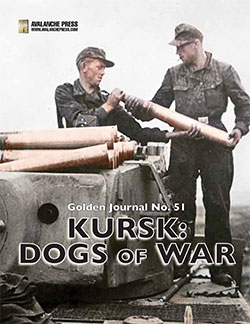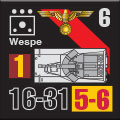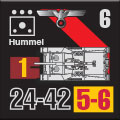| Golden Journal No. 51:
Kursk: Dogs of War
Scenario Preview
By Mike Bennighof, Ph.D.
February 2023
 Golden Journal No. 51, Kursk: Dogs of War is an unusual issue of our little magazine-like rag (which is not an actual magazine). It’s the first one that’s had an outside sponsor, a “quiet benefactor” who wanted a set of 176 SS pieces for Kursk: South Flank in the black alternative color scheme from Dishonor Before Death. So we made it happen. Golden Journal No. 51, Kursk: Dogs of War is an unusual issue of our little magazine-like rag (which is not an actual magazine). It’s the first one that’s had an outside sponsor, a “quiet benefactor” who wanted a set of 176 SS pieces for Kursk: South Flank in the black alternative color scheme from Dishonor Before Death. So we made it happen.
The Journal itself is purely our doing, though; I left journalism because I just didn’t take direction very well. In addition to the background pieces, I wanted it to have a chapter of scenarios for those new pieces, one based on actual, historical battles.
There are a lot of choices: the summer of 1943 is what one might call a scenario-rich environment, especially after the Battle of Kursk, when the Soviets begin their counter-offensives (plural). I decided not to craft more Kursk scenarios, so we can cover more Kursk in a future expansion book. Instead, I moved south about 75 kilometers and forward in time about a month, for a slice of the August 1943 Soviet Operation Rumyantsev.
Initially, I’d intended to make all of the scenarios division-sized, for team play with, say a dozen plays in play and basically all the pieces from both Burning Tigers and South Flank and maybe some from Fire in the Steppe and Broken Axis, too. I only had to play the first of them one time to realize that no one would play the second, so the others are all of normal scope. Let’s have a look at them.
Operation Rumyantsev
 One month after the German defeat at the Battle of Kursk, the Soviet Voronezh Front launched a powerful offensive code-named Operation Rumyantsev. The 1st Tank Army, replenished with fresh men and machines following the harrowing battles at Kursk, formed the spearhead of the drive designed to isolate the huge industrial city of Kharkiv, located just south of the Kursk battlefield. One month after the German defeat at the Battle of Kursk, the Soviet Voronezh Front launched a powerful offensive code-named Operation Rumyantsev. The 1st Tank Army, replenished with fresh men and machines following the harrowing battles at Kursk, formed the spearhead of the drive designed to isolate the huge industrial city of Kharkiv, located just south of the Kursk battlefield.
In the weeks after their failure at Kursk, the three SS panzer grenadier divisions had been withdrawn from the front. One of them went to Italy to shore up that ally’s commitment to the Axis, while the other two boarded south-bound trains to battle a Soviet offensive along the Mius River in southern Ukraine. When Operation Rumyantsev began they loaded their men and equipment again and returned to the Kharkiv region. This time they would be on the defensive.
Scenario One
Death’s Head at Oleksandrivka
9 August 1943
 With the Soviet 1st Tank Army pressing southward, the German Army Detachment Kempf committed the II SS Panzer Corps – now reduced to two divisions with the withdrawal of the Life Guards to Italy – to stop them. The Death’s Head Division, its tank losses made good with vehicles left behind by the Life Guards, would attack over the Merchyk River to blunt the Soviet 6th Tank Corps’ advance. With the Soviet 1st Tank Army pressing southward, the German Army Detachment Kempf committed the II SS Panzer Corps – now reduced to two divisions with the withdrawal of the Life Guards to Italy – to stop them. The Death’s Head Division, its tank losses made good with vehicles left behind by the Life Guards, would attack over the Merchyk River to blunt the Soviet 6th Tank Corps’ advance.
Conclusion
Maj. Gen. A.L. Getman’s 6th Tank Corps had fought with the 1st Tank Army at Kursk, facing the supposedly elite Grossdeutschland Division. The battered unit lost most of its tanks there, but had three weeks to draw new ones, absorb replacements and repair its damaged vehicles before taking the offensive. Thanks to superior numbers, the militiamen held the river line despite repeated Soviet attempts to force a crossing. The Germans fought to hold Oleksandrivka on the north bank, but the third attack – this time from the 112th “Revolutionary Mongolia” Tank Brigade, a crack unit with a pre-war veteran core – finally drove out the invaders. Sixth Tank Corps would be raised to Guards status two months after these battles.
Notes
This is the big scenario, and conveniently, the Soviets attacked on two axes and the Germans defended with their two regiments separated to defend each crossing. So you can pretty easily split the scenario down the middle for team play. There are an awful lot of units in play, pretty much the entire 6th Tank Corps crashing into the entire Death’s Head Division.
Scenario Two
Murafa Bridgehead
11 August 1943
 After taking a day to allow their stragglers to make it to the front and shift a few units around, the Soviets resumed their southward march. That pause also allowed the Death’s Head Division to unload more of its own artillery and armor from the trains that had moved it back to this front. In the early hours of 11 August, 1st Tank Army resumed its offensive. After taking a day to allow their stragglers to make it to the front and shift a few units around, the Soviets resumed their southward march. That pause also allowed the Death’s Head Division to unload more of its own artillery and armor from the trains that had moved it back to this front. In the early hours of 11 August, 1st Tank Army resumed its offensive.
Conclusion
After a few fumbled attempts, the militia engineers managed to explode their charges on the bridge, only to see the span remain standing. The Soviets surged across the scorched roadbed and over the river itself, driving back the militia and securing a bridgehead on the river’s south bank. There, they collected themselves to continue their attack southwards while the Death’s Head militia reeled back in some confusion.
Notes
Here we are back to a merely large scenario, with a pretty strong Soviet force (three brigades) trying to bash their way over the river, while the fairly inept SS engineers try to blow up the bridge in their faces. Even if they succeed it will only slow down the Red Army; it’s just a minor river and they can and will surge across it anyway.
Scenario Three
The Oleksandrivka Crossing
11 August 1943
 While most of 6th Tank Corps fought their way across the Merchyk at Murafa, the veteran 112th Tank Brigade joined with 3rd Mechanized Corps to renew the attack at Oleksandrivka to the east. Mikahil Katukov, commanding 1st Tank Army, identified the Death’s Head militia division as the weak link in the German defenses. Success here would also force back the German divisions fighting on either flank of the Death’s Head militia. While most of 6th Tank Corps fought their way across the Merchyk at Murafa, the veteran 112th Tank Brigade joined with 3rd Mechanized Corps to renew the attack at Oleksandrivka to the east. Mikahil Katukov, commanding 1st Tank Army, identified the Death’s Head militia division as the weak link in the German defenses. Success here would also force back the German divisions fighting on either flank of the Death’s Head militia.
Conclusion
The Death’s Head armored regiment failed to arrive on the battlefield, leaving the infantry on their own and unable to stop the Soviet river crossings. The 49th Tank Brigade from 3rd Mechanized Corps passed through the Soviet lines to take up the offensive southward alongside the “Revolutionary Mongolia” brigade (which was manned by Russians, driving tanks built with donations by the Mongolian people).
Notes
We slide upriver for another crossing scenario, but this time the SS has forgotten to send anyone to try to blow up the bridge so all they can do is fight to try to hold it while the Soviets go splashing past them on either side. The SS do have a lot of guys and a chance at tank support, so they might hold on.
Scenario Four
Kovjagi Station
11 August 1941
 Katukov’s prime objective, the rail line leading into Kharkiv from the west, lay within reach once his spearheads had fought their way across the Merchyk. The 1st Guards Tank Brigade, perhaps the best combat unit in the Red Army (formed in 1941 by Katukov himself, as 4th Tank Brigade), moved quickly to seize the rail station at Kovjagi. The Death’s Head Division had no choice but to counter-attack. Katukov’s prime objective, the rail line leading into Kharkiv from the west, lay within reach once his spearheads had fought their way across the Merchyk. The 1st Guards Tank Brigade, perhaps the best combat unit in the Red Army (formed in 1941 by Katukov himself, as 4th Tank Brigade), moved quickly to seize the rail station at Kovjagi. The Death’s Head Division had no choice but to counter-attack.
Conclusion
Despite repeated attempts, the SS militia failed to push the Soviets out of Kovjagi. The elite Soviet tankers took a heavy toll on the Germans, killing or badly wounding all of the German battle group’s senior officers. With the seizure of the station and other points along the rail lin, Katukov’s men had broken German communications into Kharkiv from the west (they still had a precarious, roundabout route to the city from the south). The Germans would bring in reinforcements and commence a counter-offensive on the next day.
Notes
And now we have a tank battle, with an elite formation! The SS couldn’t hang onto the river line in the morning (at either crossing) and now the Soviets have exploited with the legendary 1st Guard Tank Brigade (“Katukov’s Brigade”). At least the SS have unloaded more of their tanks, so they do have better armor than the Soviets, but a Twice Red Banner outfit doesn’t flinch easily.
And those are the Dogs of War scenarios.
The best part of the Golden Journal is that it’s free – that’s right, free – to the Gold Club, at least when we first offer it. After that, you have to pay for it.
The Golden Journal is only available to the Gold Club (that’s why we call it the Golden Journal).
Click here to join the Gold Club.
See your Gold Club Insider newsletter for ordering information.
Sign up for our newsletter right here. Your info will never be sold or transferred; we'll just use it to update you on new games and new offers.
Mike Bennighof is president of Avalanche Press and holds a doctorate in history from Emory University. A Fulbright Scholar and NASA Journalist in Space finalist, he has published a great many books, games and articles on historical subjects; people are saying that some of them are actually good.
He lives in Birmingham, Alabama with his wife, three children, and new puppy. He misses his lizard-hunting Iron Dog, Leopold.
Want to keep Daily Content free of third-party ads? You can send us some love (and cash) through this link right here. |
